Last Updated on June 11, 2024 by Kittredge Cherry
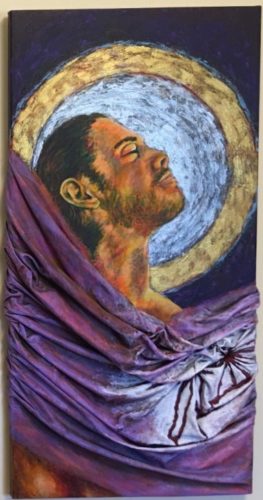 LGBTQ people and allies use art and prayer to remember the 49 martyrs killed in the massacre at the Pulse gay bar on June 12, 2016, in Orlando, Florida.
LGBTQ people and allies use art and prayer to remember the 49 martyrs killed in the massacre at the Pulse gay bar on June 12, 2016, in Orlando, Florida.
A mass shooter killed 49 people and left 53 wounded at the Pulse gay nightclub in Orlando, Florida. The hate crime / terrorist attack was the deadliest act of violence against LGBTQ people in U.S. history. At the time it was also America’s deadliest mass shooting by a single shooter — until the record was broken in Las Vegas in 2017. Tributes are presented in a variety of ways, including art, prayer and books.
Artistic tributes to those killed at the Pulse Orlando include works by Maine liturgical artist James Day, British artist Tony O’Connell, Venezuelan artist-activist Daniel Arzola and Vermont painter Janet McKenzie. The City of Orlando purchased the property to create a permanent memorial and established a Pulse Memorial Advisory Committee after the OnePULSE Foundation was dissolved in 2023 amid questions about its finances.
Orlando shooting happened on “Latin Night”
The Pulse was hosting a “Latin Night” on the night of the massacre, so most of the victims were Latinx. Many were LGBTQ people, ranging in age from 18 to 50. Most were in their 20s or 30s. Among the dead were same-sex couples who died together and a mother of 12 who was dancing with her gay son. Media reports suggest that some kept their sexual orientation or gender identity private until they were “outed” by news of their murders.
They included students, churchgoers, immigrants from many countries and native-born Americans. They had jobs such as accountant, bouncer, entrepreneur, banker, pharmacy tech, travel agent, store clerk, apartment manager, professional dancer and theme-park ride operator.
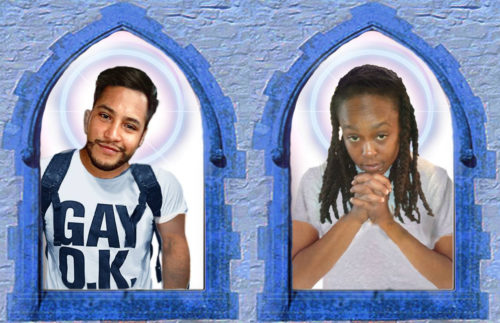
Blessed Frank Hernandez (left) and Blessed Deonka Deidra Drayton from work in progress: “Triptych for the 49” by Tony O’Connell
The gunman also died at the Pulse. Police shot and killed Omar Mateen in a three-hour standoff after he shot the victims and took hostages. The Pulse nightclub site will become a permanent memorial and museum.
Documentary films about the Pulse Orlando massacre include “49 Pulses” and “Lifeline: the Untold Story of Saving the Pulse Survivors.”
Jesus is a shooting victim in “Pulse Christ”
Jesus is pictured as one of the shooting victims in “Pulse Christ” by James Day. The painting was added to the top of this post in 2020. Day studied liturgical art and queer theology at Episcopal Divinity School in Cambridge, Massachusetts, earning a Master of Arts degree in theology before returning home to central Maine. When not caring for care for his aging mother and disabled partner, he puts his hands to a variety of visual and fiber arts, primarily focused on queer spirituality.”
“I wanted to somehow connect the suffering of the LGBTQ community with the suffering of Christ,” he wrote when he posted the image on Facebook. “The purple of the drape, a color long associated with queer folk, begins to turn white as it is touched by the blood. Much like the image of martyrs in the book of Revelation, but in this case the blood of the martyrs and the blood of the lamb are one and the same. I am still living with this image and learning what it has to say. It speaks to me also of pride, a pride rooted in suffering but transcending the pain to find peace and self worth.”
The painting inspired him to write a poem called “Pride,” based on Romans 8 and Psalm 139. It includes these lines:
“And even though they lock us away, or commit us to institutions,
Or drive us from our homes, or fire us from our jobs,
Or shower us with bullets at night clubs,
Or allow us to die from deadly diseases,
Or find any number of ways to grind us into the dust,
We will find color and light in the darkness,
We will sing together,
We will march together,
We will protest, and preach, and live lives filled with joy and love,
And, even in the face of fear and despite the hypocritical calls for false humility,
We will be proud of who we are.”
The whole poem is posted on his website.
The painting emerged in stages during Day’s artistic process, when a generic Christ figure was transformed into a Latinx Jesus whose crucifixion wounds became bullet holes, Day told Q Spirit. The work is actually three-dimensional. The stiffened fabric of Christ’s robe is pulled through real holes in the canvas.
Day completed the painting in 2019 and it is posted on Q Spirit for the first time in 2020 for the fourth anniversary of the shooting. His painting “Beloved Disciple” is included in Q Spirit’s profile of John the Evangelist.
Christ with rainbow flag and 49 stars
Grasping a rainbow over his shoulders, a suffering Christ is surrounded by 49 stars — one for each who was killed — in “Pulse,” a 2023 icon by Matthew, a practicing Roman Catholic who shares his artwork at Queer Catholic Icons on Instagram.
“Pulse” by Matthew of queer.catholic.icons
The stars evoke the 46 stars on the Virgin of Guadalupe’s robe and 50 stars of the U.S. flag. Jesus is identified by the Greek alphabets on his halo: omicron, omega and nu. They look like the capital letters OWN, but they represent God’s words to Moses in Exodus 3.14: “I am who I am.”
“Triptych for the 49” shows spiritual artistry
One of the most monumental artworks about the Orlando martyrs is “Triptych for the 49,” a mixed media piece by gay artist Tony O’Connell of Liverpool. It is a shrine shaped like three-part altarpiece. The artist mounted images of each martyr on reclaimed closet doors, along with queer saints Sebastian and Joan of Arc as “wrathful protector saints.”
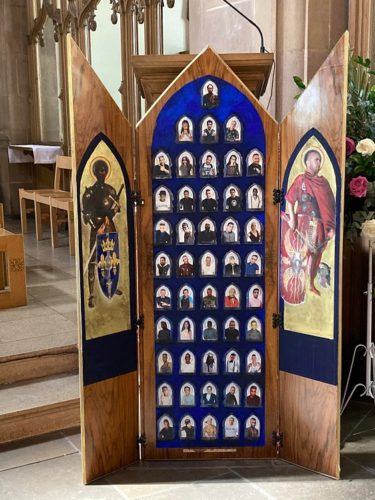
“Triptych for the 49” by Tony O’Connell at the Liverpool Parish Church of Our Lady and Saint Nicholas.
The Orlando martyrs speak to society today through Tony O’Connell’s art. “The world has changed very much in my life but Orlando reminds us that we are all still more vulnerable than polite liberal straight society would like to admit. I think every gay person must have been scarred by the massacre because it reminds us again that there is hate specifically directed at us,” he explained to Q Spirit.
In his creation, O’Connell made haunting digital images with blue haloes inside Gothic window shapes framing the faces of each person who died in the Orlando shooting. He will arrange them in rows on the central panel, flanked by the guardian saints on two hinged panels. Gold leaf ornamentation adds to the air of sanctity. The whole triptych stands almost six feet tall.
The repetition of the format for all 49 faces allows the individuality of each victim shine through. The viewer’s heart and attention are drawn here and there to connect with different souls: the one in the pink shirt, the one with tattoos, the one with the bowtie…
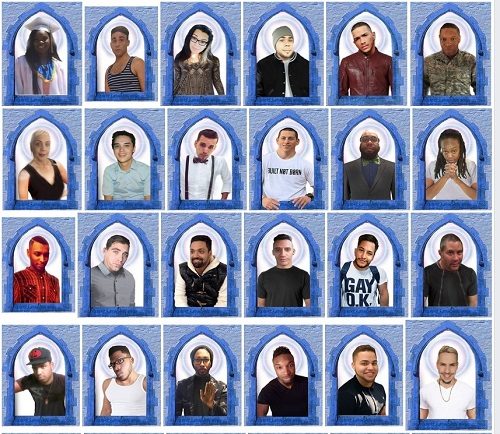
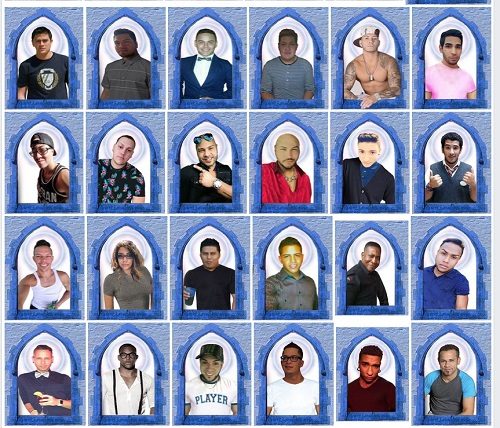
Like standard religious icons, they gaze directly into the viewer’s eyes, seeming to invite conversation. Icons are traditionally considered to be “windows to heaven,” and O’Connell’s commemorative altarpiece provides a glimpse into a queer hereafter.
It is no accident that O’Connell made his shrine to the Orlando martyrs out of wood once used as closet doors. “At some level coming out of the closet is always a revolutionary act of courage because each LGBT person knows on whatever level that the choice to come out could invite potential rejection, or violence or even worse,” he said.
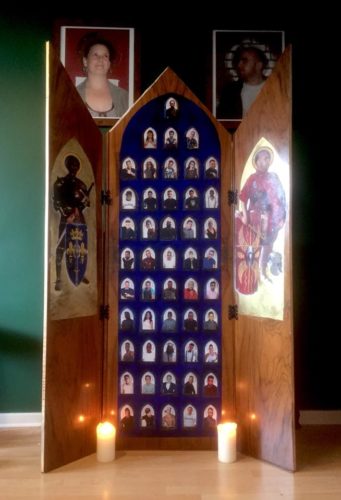
“Triptych for the 49” by Tony O’Connell is displayed with candles in its completed form
Rainbow haloes indicate that the large figures guarding the martyrs are LGBTQ saints: Sebastian Joan of Arc. Sebastian is a favorite theme in O’Connell’s art and spirituality. He re-enacted the saint’s martyrdom with a sculptural Sebastian to condemn violence against LGBTQ people in a 2015 performance art film. It included a “Litany of the Queer Saints.” He may write a new litany for the Orlando martyrs.
“Triptych for the 49” has been shown in a variety of exhibition spaces. It was part of a one-day pop-up exhibit hosted by the Liverpool Parish Church of Our Lady and Saint Nicholas for the 2022 Day Against Homophobia, an Anglican church in Liverpool, England.
Raised Roman Catholic, O’Connell was rejected by the church when he came out as gay in his teens. He has been a practicing Buddhist since 1995. Much of O’Connell’s work deals with affirming the holiness of LGBTQ lives.
O’Connell’s art is popular with readers of the Jesus in Love Blog., where his work has been featured several times. The most popular post about O’Connell’s art is “Reclaiming sainthood: Gay artist Tony O’Connell finds holiness in LGBT people and places.”
“Safe space was violated”
Queer femme autistic ChicanIndia artist Sabrina Zarco created “One Pulse” in as an art quilt tribute commemorating the 49 brown and black queer lives taken on Latin night at the Pulse nightclub and the impact on families and community. “I will always remember waking up to the news and weeping,” she said. “At the time it was the second largest mass shooting. And then I began making this work from designing the fabric to hand painting the colors. The work was my mourning cloth. It is a mixed media art quilt. It is hand painted, embroidered and quilted. Embellished with milagros, beads, buttons, toys and my tears.”
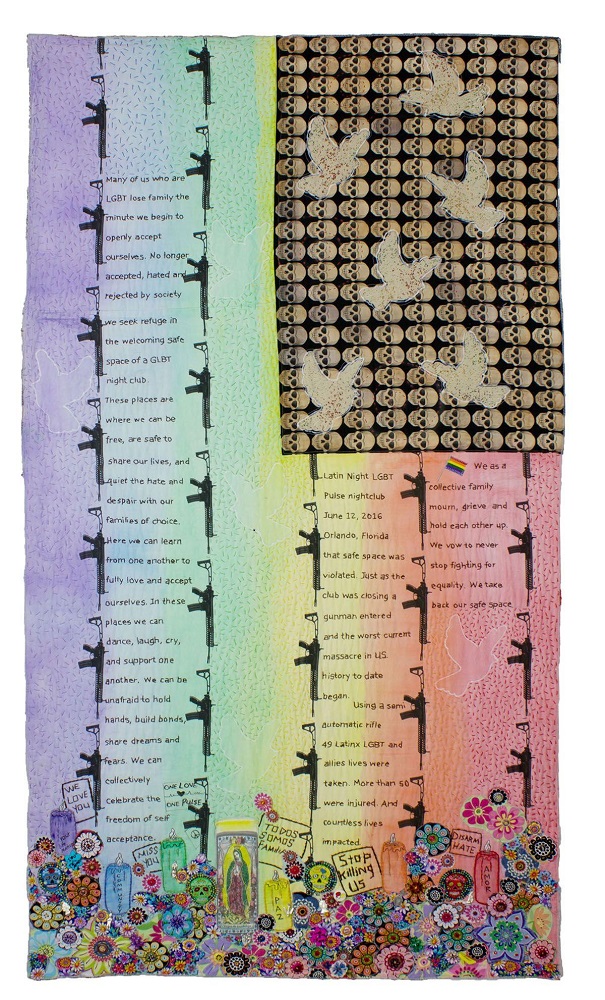
“One Pulse” by Sabrina Zarco
The large quilt, nearly five feet tall, looks like a rainbow U.S. flag with skulls instead of stars. The stripes are marked by high-capacity rifles like the type used in the Pulse shooting. Peace doves hover over the skulls. “Skull images and death in general are viewed differently in my Indigenous Mexican culture,” Zarco told Q Spirit. “Life is but one part here on Earth school our spirit has more in other realms.”
Zarco hand-stitched a text that reads in part:
“Many of us who are LGBT lose family the minute we begin to openly accept ourselves. We seek refuge in the welcoming, supportive safe space of an LGBT nightclub. These places are where we can be free, are safe to share our lives, and quiet the hate and despair with our family of choice. Here we can learn from one another to fully love and accept ourselves. In these places we can dance, laugh, cry, and support one another. We can be unafraid to hold hands, build bonds, share dreams and fears. We can collectively celebrate the freedom of self-acceptance. Latin Night LGBT Pulse nightclub, June 12, 2016, that safe space was violated.”
The altar at the bottom of the quilt depicts flowers, candles and notes that were left at the actual site. A Virgin of Guadalupe candle shines amid messages such as “We love you” and “Disarm hate.” The University Art Gallery of Central Michigan acquired “One Pulse” as part of their permanent collection.
More artists honor the Pulse Orlando martyrs
A squiggly line rises like a heart-monitor pulse from a man’s blossoming heart against a blood-red background in “Keep the Pulse! Stay with me Orlando” by Daniel Arzola. He is a gay Venezuelan “artivist” or artist-activist who uses art as a tool of social transformation.
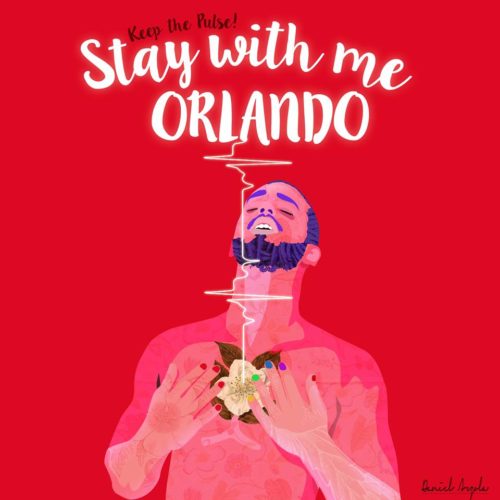
“Keep the Pulse! Stay with me Orlando” by Daniel Arzola
His Pulse memorial features his signature style of simple, eye-catching images with bold colors. In 2013 Arzola created the ¨I’m Not a Joke¨ (No Soy Tu Chiste) project, the first LGBTQ viral campaign in Venezuela. Its worldwide success led to a backlash and death threats that forced him to live in exile in Chile.
Another artwork honoring those who lost their lives at the Pulse is “A Brave and Quiet Heart” by Vermont artist. Janet McKenzie. The painting shows an androgynous figure draped in a rainbow flag offering outstretched hands against a lavender backdrop while doves suggest the Holy Spirit or angel wings. Like the dark-skinned young person with a faux-hawk haircut in McKenzie’s painting, most of the 49 dead were LGBTQ people of color in their 20s or 30s. For more info, see Q Spirit’s article “LGBTQ community gets spiritual affirmation in new art by Janet McKenzie.”
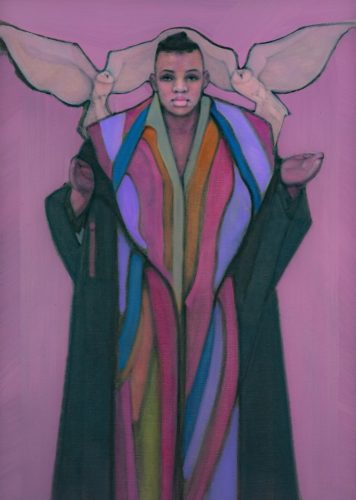
“A Brave and Quiet Heart” by Janet McKenzie
Pulse Orlando prayers: “God of glitter and grit, hear our prayer”
Q Spirit’s Litany of Queer Saints includes this line:
Pulse 49 Martyrs of Orlando, shielding those you loved with your own bodies, pray for us and lend us your courage.
Other prayers inspired by he Pulse Orlando shooting include “49 Reasons: Remembering the Victims of Pulse,” written by Margarita Sánchez De León for the Metropolitan Community Churches Council of Elders in 2019. The full bilingual prayer is available in English and Portuguese. It includes these lines:
Today, three years after mass shooting at Pulse in Orlando, Florida, we ask you not to forget, but that we can pronounce each one of those 49 names into the wind. That in the same way we do not forget all the fallen victims of everyday hate, exclusion and injustice.
Although we are still asking why, we ask you that rather give us 49 things that we can do differently in our families, in our communities, in our congregations, in our countries to subvert the lack of love and to change oppression.
“Prayers of Thanksgiving for Pulse and every Gay Bar” was written by Jac Cherry, a deacon at the Episcopal Church of Saint John the Evangelist in San Francisco.
With what can we compare the kingdom of God?
The kingdom of God is like a gay bar.
Eternal Creator, lover of all, the heavens cannot contain you;
Inside the walls of this gay bar, O God, we feel your embrace.
For our Community universal of which this building is a symbol,
We thank you, God.
For your presence whenever two or three have gathered,
We thank you, God.
For this place where we may be still and know that we are loved,
We thank you, God.
For this sanctuary where we are free to prance, swagger, and two-step,
We thank you, God.
For dark corners where bodies are worshipped,
We thank you, God.
For the fellowship of daddies and dykes, fairies and femmes,
We thank you, God.
For the balm of refuge from our homophobic world,
We thank you, God.
For blessing our queer kinships and colorful families,
We thank you, God.
May you sanctify and protect our holy places, O God,
and may your unconditional love be known to all who cross the thresholds. Amen.
A powerful prayer of commitment and litany of remembrance comes from the Pulse Memorial Service hosted by Metropolitan Community Churches in Orlando on the first anniversary of the massacre. Some highlights of their prayers include:
“God of life and justice, we thank you for your creation. For bodies that sweat, that move to the beat of music, that embrace one another with passionate desire. We thank you for the ministry of the dance floor that connects us to one another across generations, languages, skin tones and economic status…
We gather to remember the lives of 49 people who were murdered in the Pulse nightclub shooting…
God who remembers, hear our prayer.
We place in your tender hands families that were torn apart, lovers who lost their love, parents who lost their children, friends who lost their friends.
God of reconciliation, hear our prayer.
We remember the 53 people who were wounded and the countless others who wee wounded spiritually, psychologically and physically in other ways.
God of healing, hear our prayer.
Grant us the strength to seek forgiveness for the shooter.
God who forgives, hear our prayer.
Bind us together in our compulsion to continue our unfinished calling and prophetic destiny to demand, proclaim and do justice in the world.
God of enduring love, hear our prayer.
Allow us to be ever mindful of the important work to unite sexuality and spirituality, working to be united in body and spirit. Help us affirm our bodies, our genders, our sexualities and the bodies, genders and sexualities around us.
God of glitter and grit, hear our prayer.
***
Orlando is named in a powerful Pride Month hymn commissioned for the 2019 LGBTQ Pride celebration at Trinity Episcopal Church in Everett, Washington. Composed by Henry Lebedinsky, it includes these stanzas:
As we journey on together,
We remember those we’ve lost,
Those who could not make the voyage,
Those whose lives have paid the cost.
Stonewall, Laramie, Orlando…
Change borne on a sea of tears,
Bitter struggle, bitter hatred,
So much pain from so much fear.…
Through the years of loss and conflict,
We’ve been called to turn our hearts,
And together, be Love’s beacon
When all other light departs.
May we be the light God made us,
Rays of hope in times of pain;
Peace and justice be our promise,
Sunlight shining through the rain.
Books aid Orlando survivors
Many other artists have also created tributes to the Orlando martyrs. For example, artists and writers from the comic book industry turned the tragedy into art with the book “Love is Love: A Comic Book Anthology to Benefit Survivors of the Orlando Pulse Shooting.” A long list of contributors uses art to mourn those killed in Orlando, support the survivors and celebrate the LGBTQ community. It was published by IDW Publishing in cooperation with DC Comics.
artists have also created tributes to the Orlando martyrs. For example, artists and writers from the comic book industry turned the tragedy into art with the book “Love is Love: A Comic Book Anthology to Benefit Survivors of the Orlando Pulse Shooting.” A long list of contributors uses art to mourn those killed in Orlando, support the survivors and celebrate the LGBTQ community. It was published by IDW Publishing in cooperation with DC Comics.
Poets joined together for a different book with a similar title and approach: “Love is Love: Poetry Anthology in Aid of Orlando’s Pulse Victims and Survivors.” Edited by Lily Blunt, it brings together more than 50 LGBTQ and straight allies from around the globe. They celebrate love and acceptance in the face of the hate, bigotry and senseless violence of the Orlando shooting.
“A Place for Us,” a coming-of-age memoir by Pulse survivor Brandon J. Wolf, was published in 2023.

Martyrs of Orlando adapted from “Gay Mourning Flag” (Wikimedia Commons)
Other acts of violence and harassment at LGBTQ bars
Before Orlando the deadliest U.S. attack on LGBTQ people was the UpStairs Lounge fire, which killed 32 people in New Orleans on June 24, 1973.
Sadly both of these mass murders came during LGBT Pride Month, which marks the 1969 Stonewall rebellion at another gay bar: the Stonewall Inn in New York City.
Martyrs are those killed for a cause. May the souls of those killed in Orlando be welcomed to heaven by the LGBTQ saints and by history’s many queer martyrs who were killed for their sexual orientation or gender expression.
 |
| Memorial image trending on social media |
Rainbow Christ destroys gun
No longer a victim, Jesus breaks a gun apart while his rainbow halo shines in “Rainbow Christ-Sophia the Peace Maker” by Jeremy Whitner. Shock waves ripple outwar from Christ’s radical act of non-violence. The painting responds not only to the Pulse, but also to a larger trend that unfortunately includes many other mass shootings. “All the gun violence was weighing on my mind,” Whitner told Q Spirit. He painted it in 2022, a few weeks after 19 died in the shooting at Robb elementary school in Uvalde, Texas. It is also inspired by “Christ Breaks the Rifle,” a woodcut by Otto Pankok, a German who was declared a “degenerate artist” by Hitler..
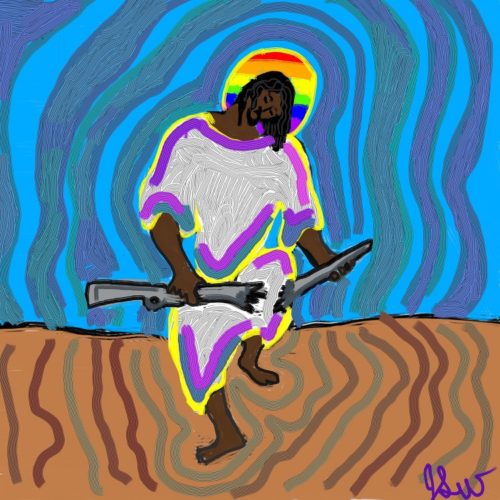
“Rainbow Christ-Sophia the Peacemaker” by Jeremy Whitner
The image echoes the scripture where the prophet Isaiah urges nations to turn their weapons into peaceful tools: “They shall beat their swords into plowshares, and their spears into pruning hooks; nation shall not lift up sword against nation, neither shall they learn war anymore.” (Isaiah 2:4)
It is part of the Rainbow Christ-Sophia series that Whitner began painting in early 2022. The series includes a Last Supper, two different styles of crucifixion, a Pieta and a Resurrection. Many of them can be seen in the Q Spirit article “Black Jesus, Latinx Jesus and other liberating visions join the gay Passion of Christ.” The series was inspired by the Rainbow Christ Prayer by Kittredge Cherry and Patrick Cheng.
The name Rainbow Christ-Sophia evokes the solidarity of Jesus with women and the LGBTQ community, whose symbol is the rainbow flag. Sophia is Greek for “wisdom” and represents the female incarnation of Wisdom in the Bible (Proverbs 8:22-31). Sophia has been interpreted as a Christ figure since the early church, and she has appeared in Byzantine churches and icons at least since the Middle Ages. Rainbows also show the full spectrum of light and stand for God’s promise to support all life on earth.
Whitner is a queer Christian iconographer in process for ministry with the Disciples of Christ while attending Union Presbyterian Seminary in Charlotte. He has also painted many icons for the LGBTQ Saints series at Q Spirit. Prints and other items with his artwork are available through his shops at Fine Art America and Pixels.
Links related to the Orlando martyrs
‘They Were So Beautiful’: Remembering Those Murdered In Orlando (NPR.org)
Litany for Orlando by Yvonne Aburrow (Dousing for Divinity)
___
Top image credit:
“Pulse Christ” by James Day
___
This post is part of the LGBTQ Saints series by Kittredge Cherry. Traditional and alternative saints, people in the Bible, LGBTQ martyrs, authors, theologians, religious leaders, artists, deities and other figures of special interest to lesbian, gay, bisexual and transgender and queer (LGBTQ) people and our allies are covered.
This article was originally published in June 2017, was expanded with new material over time, and was most recently updated on June 11, 2024.
Copyright © Kittredge Cherry. All rights reserved.
Qspirit.net presents the Jesus in Love Blog on LGBTQ spirituality.


















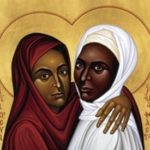
Fabulous post. The artwork is beyond wonderful!
Thank you so much – I’ve just seen your kind comment – I finished the recent exhibition of this piece and other related work as part of a show called “Thresholds” in Liverpool and images of some of these -along with other artists, are shown in another folder in my Facebook photos – I will open the privacy settings on that folder too so you can see the finished work if you would like to or feel free to add me